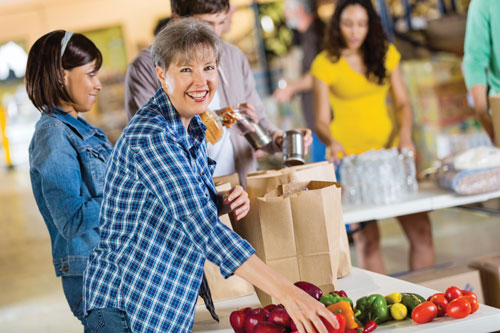
Bulletin E3201
Michigan Fresh: Fresh Produce Donation Guidelines for Gardeners
DOWNLOAD
January 23, 2015 - Katherine Hale
Gardeners can help feed hungry people by donating extra produce to food pantries.
Fresh Produce Donation Guidelines for Gardeners
Hungry people need good food – and gardeners can provide safe, nutritious food to those who might otherwise go without. Community and school gardens, orchards, farms and home gardens can be great sources of fresh local produce for food pantries.
Food banks and pantries generally welcome donations of fresh produce from community gardeners, but it’s important to check with them before making a delivery. Ask whether they can accept produce at their site, and if they can, whether they need the type of produce you have to donate. (Some days, accepting 10 more bags of zucchini just isn’t feasible for even the largest food pantry).
Bill Emerson Good Samaritan Food Donation Act protects food donors
Gardeners who donate food (such as produce from their gardens) and grocery products to nonprofit organizations for distribution to people in need are protected from criminal and civil liability by the federal Bill Emerson Good Samaritan Food Donation Act. The act was named for U.S. Representative Bill Emerson (Missouri) for his “long-standing support of issues relating to the hungry.” It was signed into law in 1996 by President Bill Clinton.
Under terms of the bill, donors are protected from civil and criminal liability should the product donated in good faith later cause harm to the recipient. It also standardizes donor liability exposure and sets a floor of “gross negligence” or intentional misconduct for persons who donate grocery products.
To find out more about the Good Samaritan Food Donation Act, visit Feeding America at feedingamerica.org/get-involved/corporate-opportunities/become-a-partner/become-a-product-partner/protecting-our-food-partners.aspx.
Handling Produce
Follow these steps when selecting, handling, storing and transporting the produce you plan to donate:
- Offer only good quality, freshly picked produce to food pantries.
- Handle fresh fruits and vegetables safely to minimize the risk of foodborne illness.
- Don’t mix produce types. Keep each type in separate, clean, food-grade containers or bags.
- · Clean as much mud and dirt as possible off of the produce you plan to donate.
- Choose produce that has no signs of mold, spoilage, bruising or insects.
If you have a large amount of produce to donate, call the food pantry at least one day ahead of time to find out their preferred delivery days and times. It’s best if you can avoid interfering with other operations at the food pantry site. You may eventually want to talk with the pantry organizers about a weekly delivery schedule.
Michigan State University (MSU) Extension experts recommend that you harvest produce early in the morning. If it’s covered with dew, dry it with paper towels. Inspect each item for serious bruising, insect damage and over-ripeness. Don’t donate produce that you wouldn’t buy for your own family. This includes produce that is overripe, has mushy spots or is seriously blemished.
“If you use pesticides in your garden, always read and follow the label recommendations for use of the pesticide,” says Phil Tocco, MSU Extension educator in agrifood safety. “Pay particular attention to the time to harvest after last use before you harvest. If you are not absolutely sure that you followed the label when using pesticides, the food should be landfilled and not composted, eaten or donated,” Tocco concludes.
For more information
- Fresh Fruits, Vegetables and Juices page of Foodsafety.gov at www.foodsafety.gov/keep/types/fruits/index.html#.Ug51eG2zLms.
Your produce donation to a local food pantry will help everyone meet the U.S. Department of Agriculture recommendation (see www.choosemyplate.gov) that Americans eat more fruits and vegetables. Michigan Fresh (msue.anr.msu.edu/program/info/mi_fresh), which is part of MSU Extension, has information on recommended varieties, storage, food safety and preserving techniques for fruits and vegetables.
To find a food bank or food pantry in your area:
- Search online.
- Check your local phone directory.
- Contact local community service agencies and faith-based organizations.
- Visit the Michigan Association of United Ways at uwmich.org.
For more information about MSU Extension community food systems programming, visit msue.anr.msu.edu and search for “community food systems” or contact Kathe Hale at halek@anr.msu.edu. To learn about the nutrition education that MSU Extension nutrition instructors provide to SNAP-Ed recipients, contact Eileen Haraminac at haramin2@anr.msu.edu.
Prepared by: Katherine E. Hale and Eileen Haraminac, MSU Extension Educators



 Print
Print Email
Email



